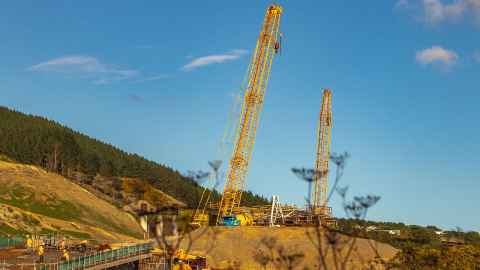Councils need help with environment balancing act
28 June 2021
Opinion: Councils need guidance on the contradiction of making environmental improvements while hand-in-hand with economic growth, writes Stephen Knight Lenihan.

Throughout the late 1990s and 2000s researchers examined failures to address declining ecosystems and poor development outcomes. They noted among other things the lack of central government guidance and under-resourcing of local government.
A 2020 Resource Management Review Panel (RMRP) highlights similar problems. The solution adopted by Government is to dump the Resource Management Act 1991 and create new legislation. The earlier research demonstrated that on its own, this won’t solve the problem. What is also needed is directly helping, and substantially so, local councils and communities to deliver. Also needed is more honesty about the contradiction of promoting environmental improvements hand-in-hand with economic growth.
The proposed new legislation favours a shift toward enhancing environmental quality. This might lead to development that contributes to halting or reversing ecological decline. A good idea, and better than the usual practice of avoiding harm. But challenging because it depends on techniques that have a patchy track record, depend on good design and implementation, and assume levels of monitoring and compliance that are probably outside current council capacity.
Further challenging councils is an RMRP recommendation requiring a link between improving environmental quality and supporting the wellbeing of present and future generations. Human health and happiness depend on well-functioning ecosystems, but a default for wellbeing remains economic growth. Growth borrows heavily from natural resources, creating the problems we are currently trying to address. Development projects having to enhance the environment while supporting economic growth may work in the margin but generate contradictory outcomes in the long term.
Another laudable panel recommendation is working within biophysical (environmental) limits. However, there is a carry-over from debate under the current Resource Management Act 1991 relating to the need to account for environmental bottom lines. The RMRP says EBLs delineate boundaries or points where significant and potentially irreversible harm to the environment occur, biophysical tipping points determined in accordance with laws and interactions existing in nature.
These are ecologically difficult concepts to measure and apply. Far better, and something that could evolve from the panel review recommendations, is the idea of working within biophysical capacity to improve ecosystem values. We have a version of this already with the National Policy Statement for Freshwater Management (NPSFM).
To be fair, while getting rid of EBLs makes a council’s life easier, introducing the need to identify biophysical capacity and assess ecosystem improvements does not. This is because of the lack of council resources to undertake baseline monitoring, approve well-designed projects, and then monitor, police, and enforce compliance. Hence the need to clarify how this will be resourced.
Adding to the complexity is this month’s Climate Change Commission recommendations requiring changes to meet emissions budgets. Local decisions being made today lock in land and resource use and associated emissions.
For example, central government and councils must work out how the new (2020) Urban Development Act provisions creating Specified Development Project (SDP) Areas (UDA s10) interacts with local plans. The UDA gives the also new (2019) Kāinga Ora – Homes and Communities crown entity provision to override existing local plans. Within the SDPs, Kāinga Ora may become a planning authority, modify existing plans, become a roading authority, and acquire public land.
While SDPs have to provide for or enable low-emission urban environments, this is just one of five outcomes. The others include providing or enabling integrated and effective use of land and buildings, quality infrastructure, and efficient, effective and safe transport. Councils are also required to ensure sufficient development capacity exists for the next 30 years to meet expected demand, as required statutorily by the National Policy Statement on Urban Development 2020.
There is a conflict between emissions reductions and infrastructure investment. Notwithstanding the Government’s downgrading of the Mill Road transport corridor partly on emissions grounds, local planning authority Auckland Council recognises the clash between achieving its 2030 emissions reduction targets while coping with urban development and associated infrastructure. In essence, it can’t be done.
The Council’s draft 2021 Regional Land Transport Plan says incentivising electric vehicle uptake could contribute to reducing total transport emissions in 2031 by up to 12 percent compared to the baseline year 2016. Current business as usual projections are for increasing emissions. However, even with comprehensive EV uptake, this will still mean missing the Council’s Climate Action Plan 2031 target of a 50 percent reduction in regional emissions.
The above encapsulates the contradictory pressures on regulatory authorities, businesses, employees, landowners - basically all of us - to accommodate massive global shifts while running a system increasingly out of kilter with addressing those goals. It creates two realities. One involves trying to reverse the accumulated impact of two centuries of drawing down on global natural capital as a result of population growth, technological progress, cheap non-renewable energy, and affluence. The other works within the internal logic of an economic system built on being able to draw down on that capital.
To date, the Government has not been up front on the extent to which improving human wellbeing while staying within (or more correctly returning to) biophysical limits and reducing emissions challenges economic assumptions. Additionally, communities and councils need guidance on prioritising actions and coping with what will be inequitable costs, along with a boost in their capacity to address those priorities. These fundamentals need addressing.
Dr Stephen Knight-Lenihan is a senior lecturer in the School of Architecture and Planning, Faculty of Creative Arts and Industries.
This article reflects the opinion of the author and not necessarily the views of the University of Auckland.
Used with permission from Newsroom Councils need help with environment balancing act 28 June2021.
Media queries
Alison Sims | Research Communications Editor
DDI 09 923 4953
Mob 021 249 0089
Email alison.sims@auckland.ac.nz